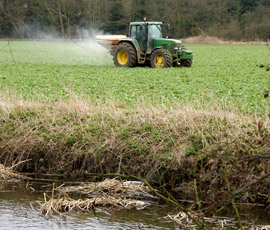Ways to reduce the risks of water pollution

Staying on the right side of the law when it comes to protecting watercourses is vital for any farming business.
The pressure is on the agricultural industry to clean up our streams, lakes and rivers and reduce levels of diffuse pollution.
The driver is the Water Framework Directive, which lays down targets for improved water quality across Europe.
But what can farmers do to make sure they get things right? Here are five simple tips:
Whole-farm appraisal
A simple whole-farm appraisal is the way for farmers to highlight potential pollution problems and more easily identify areas where valuable inputs are going to waste.
It is usually completed by a Catchment Sensitive Farming Officer with the farmer or agronomist. But it is relatively simple to prepare and you can do much of it yourself.
Applying pesticides
The challenge of keeping pesticides, especially autumn- applied weedkillers, out of surface and groundwaters is vital for farmers and water companies alike.
Preventing run off relies on farmers following best practice when it comes to buffer strips and cultivations, as well as the application of the chemicals themselves.
Buffer strips
Buffer strips may be specific planted areas alongside watercourses or they may be areas of established crops left unsprayed. In either case, the aim is to prevent pesticides entering water or hedges, either through direct application, drift or run-off.
Biobeds and filters
Getting the right sprayer step is also critical to protecting watercourses from pollution. One of the most common challenges, in even the best set up spraying operations, is dealing with spills as well as washings from containers and sprayers.
It may sound trivial, but 40% or more of all pesticides that are detected in water come from poor practice during sprayer filling and washing.
Farm tracks
Another crucial area is farm tracks which can act as pollution pathways. There is no “one size fits all” solution for this. However, run-off can often be channelled into appropriate areas for this water to be safely dispersed or slowed, such as culverts and ditches, low erosive, well drained grassland or sediment traps.
Complete the full Farmers Weekly Academy course on water protection and water stewardship

